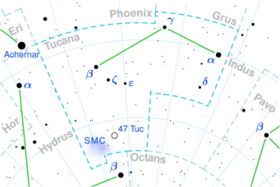Astronomy:Gamma Tucanae
| Observation data Equinox J2000.0]] (ICRS) | |
|---|---|
| Constellation | Tucana |
| Right ascension | 23h 17m 25.77222s[1] |
| Declination | −58° 14′ 08.6287″[1] |
| Apparent magnitude (V) | +3.99[2] |
| Characteristics | |
| Spectral type | F1 III[2][3] or F3 IV/V[4] or F4 V[5] |
| U−B color index | -0.02[6] |
| B−V color index | +0.39[6] |
| Astrometry | |
| Radial velocity (Rv) | +18.4±0.7[7] km/s |
| Proper motion (μ) | RA: -35.83[1] mas/yr Dec.: +81.16[1] mas/yr |
| Parallax (π) | 43.37 ± 0.63[1] mas |
| Distance | 75 ± 1 ly (23.1 ± 0.3 pc) |
| Absolute magnitude (MV) | 2.18[8] |
| Details | |
| Mass | 1.55[2] M☉ |
| Radius | 2.2[9] R☉ |
| Luminosity | 11.33[8] L☉ |
| Surface gravity (log g) | 3.92[10] cgs |
| Temperature | 6,679[10] K |
| Metallicity [Fe/H] | −0.22[8] dex |
| Rotational velocity (v sin i) | 94[11] km/s |
| Age | 1.414[10] Gyr |
| Other designations | |
| Database references | |
| SIMBAD | data |
Gamma Tucanae, Latinized from γ Tucanae, is a star in the constellation Tucana, marking the toucan's beak.[13] It is faintly visible to the naked eye with an apparent visual magnitude of +3.99.[2] Based upon an annual parallax shift of 43.37 mas as seen from Earth,[1] this star is located about 75 light years from the Sun. It is moving away from the Sun with a radial velocity of +18 km/s.[7]
There is disagreement in the literature as to the stellar classification of this star. Malaroda (1975) has it catalogued as F1 III, which would suggest it is an evolved F-type giant star.[3] Houk (1979) listed it as F3 IV/V, which appears to indicate a less evolved F-type star transitioning between the main sequence and subgiant star.[4] Gray et al. (2006) has it classed as F4 V, which would match an ordinary F-type main-sequence star.[5]
This star is a suspected astrometric binary.[14] The visible component has 1.55 times the mass of the Sun[2] and 2.2[9] times the Sun's radius. At the age of around 1.4[10] billion years, it retains a relatively high rate of spin with a projected rotational velocity of 94 km/s.[11] It is radiating 11[8] times the Sun's luminosity from its photosphere at an effective temperature of 6,679 K.[10]
Gamma Tucanae may (95% chance) have a distant co-moving companion – a magnitude 6.64 G-type main-sequence star of class G0 V designated HD 223913. This object has the same mass as the Sun and is separated from Gamma Tucanae by about 11 ly (3.5 pc).[15]
References
- ↑ 1.0 1.1 1.2 1.3 1.4 1.5 Van Leeuwen, F. (2007). "Validation of the new Hipparcos reduction". Astronomy and Astrophysics 474 (2): 653–664. doi:10.1051/0004-6361:20078357. Bibcode: 2007A&A...474..653V. Vizier catalog entry
- ↑ 2.0 2.1 2.2 2.3 2.4 Shaya, Ed J.; Olling, Rob P. (January 2011), "Very Wide Binaries and Other Comoving Stellar Companions: A Bayesian Analysis of the Hipparcos Catalogue", The Astrophysical Journal Supplement 192 (1): 2, doi:10.1088/0067-0049/192/1/2, Bibcode: 2011ApJS..192....2S
- ↑ 3.0 3.1 Malaroda, S. (August 1975), "Study of the F-type stars. I. MK spectral types", Astronomical Journal 80: 637–641, doi:10.1086/111786, Bibcode: 1975AJ.....80..637M.
- ↑ 4.0 4.1 Houk, Nancy (1979), Michigan catalogue of two-dimensional spectral types for the HD stars, 1, Ann Arbor, Michigan: Department of Astronomy, University of Michigan, Bibcode: 1978mcts.book.....H.
- ↑ 5.0 5.1 Gray, R. O. et al. (July 2006), "Contributions to the Nearby Stars (NStars) Project: spectroscopy of stars earlier than M0 within 40 pc-The Southern Sample", The Astronomical Journal 132 (1): 161–170, doi:10.1086/504637, Bibcode: 2006AJ....132..161G.
- ↑ 6.0 6.1 Ducati, J. R. (2002). "VizieR Online Data Catalog: Catalogue of Stellar Photometry in Johnson's 11-color system". CDS/ADC Collection of Electronic Catalogues 2237. Bibcode: 2002yCat.2237....0D.
- ↑ 7.0 7.1 Gontcharov, G. A. (2006). "Pulkovo Compilation of Radial Velocities for 35 495 Hipparcos stars in a common system". Astronomy Letters 32 (11): 759–771. doi:10.1134/S1063773706110065. Bibcode: 2006AstL...32..759G.
- ↑ 8.0 8.1 8.2 8.3 Anderson, E.; Francis, Ch. (2012). "XHIP: An extended hipparcos compilation". Astronomy Letters 38 (5): 331. doi:10.1134/S1063773712050015. Bibcode: 2012AstL...38..331A. Vizier catalog entry
- ↑ 9.0 9.1 Allende Prieto, C.; Lambert, D. L. (1999). "Fundamental parameters of nearby stars from the comparison with evolutionary calculations: Masses, radii and effective temperatures". Astronomy and Astrophysics 352: 555–562. Bibcode: 1999A&A...352..555A. Vizier catalog entry
- ↑ 10.0 10.1 10.2 10.3 10.4 David, Trevor J.; Hillenbrand, Lynne A. (2015). "The Ages of Early-Type Stars: Strömgren Photometric Methods Calibrated, Validated, Tested, and Applied to Hosts and Prospective Hosts of Directly Imaged Exoplanets". The Astrophysical Journal 804 (2): 146. doi:10.1088/0004-637X/804/2/146. Bibcode: 2015ApJ...804..146D. Vizier catalog entry
- ↑ 11.0 11.1 Hoffleit, D.; Warren, W. H. (1995). "VizieR Online Data Catalog: Bright Star Catalogue, 5th Revised Ed. (Hoffleit+, 1991)". VizieR On-line Data Catalog: V/50. Originally Published in: 1964BS....C......0H 5050. Bibcode: 1995yCat.5050....0H.
- ↑ "Gamma Tucanae". SIMBAD Astronomical Database. Centre de Données astronomiques de Strasbourg. http://simbad.u-strasbg.fr/simbad/sim-id?Ident=Gamma+tuc&NbIdent=1&Radius=2&Radius.unit=arcmin&submit=submit+id.
- ↑ Knobel, E. B. (1917). "On Frederick de Houtman's Catalogue of Southern Stars, and the Origin of the Southern Constellations". Monthly Notices of the Royal Astronomical Society 77 (5): 414–32 [430]. doi:10.1093/mnras/77.5.414. Bibcode: 1917MNRAS..77..414K. https://zenodo.org/record/1431899.
- ↑ Eggleton, P. P.; Tokovinin, A. A. (September 2008), "A catalogue of multiplicity among bright stellar systems", Monthly Notices of the Royal Astronomical Society 389 (2): 869–879, doi:10.1111/j.1365-2966.2008.13596.x, Bibcode: 2008MNRAS.389..869E.
- ↑ Shaya, Ed J.; Olling, Rob P. (January 2011), "Very Wide Binaries and Other Comoving Stellar Companions: A Bayesian Analysis of the Hipparcos Catalogue", The Astrophysical Journal Supplement 192 (1): 2, doi:10.1088/0067-0049/192/1/2, Bibcode: 2011ApJS..192....2S
 |


